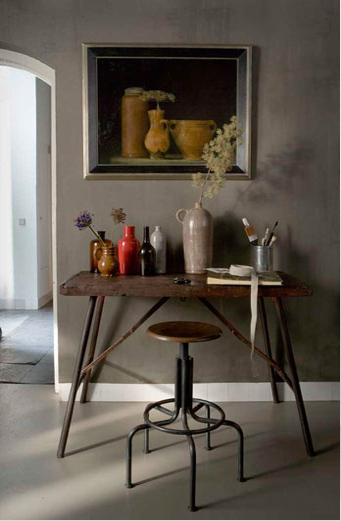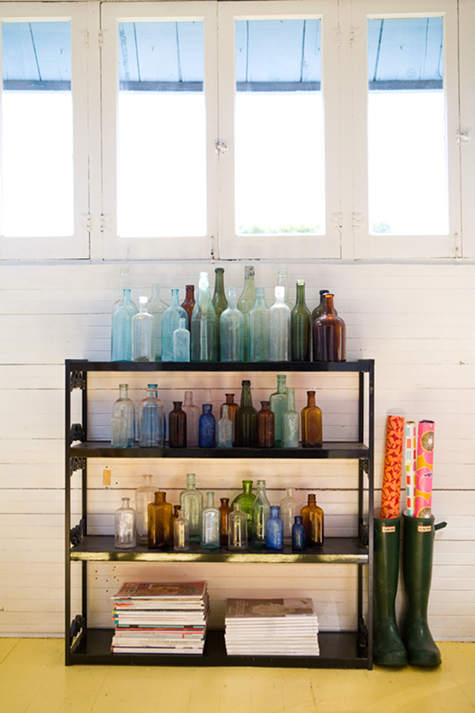Giorgio Morandi (July 20, 1890 – June 18, 1964) was an Italian painter, etcher, and printmaker who specialized in the form of still life. His paintings are all within a similar tonal subtlety. His entire career was dedicated to depicting apparently simple subjects, which were limited mainly to vases, bottles, bowls, flowers, and landscapes – all found within his own studio. Often Morandi would paint the same arrangements of bottles and accoutrement several times from various angles. Familiar forms and shapes repeat within his work constantly – thus creating a world in which the viewer feels accustomed to the repeating items in Morandi’s life. A few times Morandi delved into the world of portrait or landscape, but most of his some 1350 oil paintings were still life repetitions of objects. He explained: “Nothing is more abstract than reality”.

All images above – © Serena Mignani – Imago Orbis / A close-up of part of some of the objects left in Morandi’s studio after his death, found HERE.

Giorgio Morandi, Nature morte, huile sur toile, 1929, 390 x 52,7 mm, private collection.

Giorgio Morandi, Still Life, 1961, 10 x 12 inches

Giorgio Morandi, Natura Morta, 1962, Bildgröße 31 x 36 cm, VG Bild-Kunst, Bonn 2007, Museum für Gegenwartskunst Siegen

Giorgio Morandi, Still Life, 1940, 16 x19 inches

Giorgio Morandi, Still Life, 1949, 14 x 18 inches

Giorgio Mordani, Still Life, 1954, 10 x 28 inches

Giorgio Morandi (Italian, 1890-1964). Still Life, 1947. Oil on canvas. 8 1/6 x 10 13/16 in. (20.7 x 27.5 cm). The Cartin Collection, © 2008 Artists Rights Society (ARS), New York / SIAE, Rome

Herbert List, Giorgio Morandi in his studio, Bologna 1953 © Herbert List Estate, Magnum Photos
Seeing a pattern here?
Morandi’s rearrangements of a limited number of everyday objects forces me to reevaluate (and feng shui) my everyday objects. What if a plate I kept on a shelf was suddenly moved to another table? What if I start displaying my mugs outside of the constraints of a cabinet? What do these objects do for me and how does placement affect emotions? Morandi reexamines that which is often overlooked – forcing the viewer to see bottles and cans as almost abstract pieces – without context. Morandi broke the rules of any first-year art student is. Rather than painting a still life as a form of perspective, size, and placement – his habit of aligning objects so that their contours form a continuous, flattening line, makes all objects seem level, collapsed, and devoid of depth. If you want to experience his objects in person, the house in via Fondazza 36, where Giorgio Morandi lived and worked from 1910 to 1964 was opened to the public on 17th October 2009 as Museo Morandi.

Rebecca Harp, “Morandi by the Bed,” Oil on linen, 14 x 18 inches, found HERE.

Yoram Neder (Israeli, born 1944) Homage to Georgio Morandi, 1996

Photo: Jeroen van der Spek

Inspired by the still lifes of Giorgio Morandi, these functional and versatile pieces are organic in shape and finished with a simple matte glaze. They look great individually or as a collection. Purchase, HERE.

Morandi Mood Vases by Nadia Pignatone. Image via UK Elle Decoration December 2010.
 Luigi Ghirri, Atelier Giorgio Morandi, Grizzana, Bologna, 1989–90, found HERE.
Luigi Ghirri, Atelier Giorgio Morandi, Grizzana, Bologna, 1989–90, found HERE.

Bottles on display in a very unique way. Vases and containers as art. Image via the Shelterness, HERE.

A fresh and natural take on Morandi’s obsessive arranging via Better Homes and Gardens, HERE.

Rachel Thurston’s home via DesignSponge. She explains, “For our wedding we used old glass bottles as table decoration and after the fact, thought they would be a perfect addition to our yellow sun porch. We bought most of the bottles at the Rose Bowl Flea Market.” Image found HERE.

Le Morandine candles. The ‘Le Morandine‘ candle series by Sonia Pedrazzini has successfully managed to transform the protagonists in Morandi’s Still Life paintings into Real Life objects. “You may place these candles around haphazardly or move them around to find the perfect arrangement. Or you may, every morning, or even every hour, change their positioning, either slightly or drastically, in the search for a better arrangement. You may even just move them around on a whim, as a game, or yield to sudden inspiration.” – Marco Senaldi. Photo © Sonia Pedrazzini
 Vintage bottle collection in family dining room, found HERE, © 2011 Tina Crespo
Vintage bottle collection in family dining room, found HERE, © 2011 Tina Crespo

This rustic and french antique looking display of gerbera daisies via Chateau Chic, HERE, as a celebration of spring weather!
 The TranSglass Recycled Vases and glassware by Emma Woffenden & Tord Boontje, found HERE, available for purchase HERE (very reasonably priced).
The TranSglass Recycled Vases and glassware by Emma Woffenden & Tord Boontje, found HERE, available for purchase HERE (very reasonably priced).

“Bottle Display: Snag a stained glass effect in seconds. Just display colored-glass jars and vases on windowsills.” — Thomas Jayne, Thomas Jayne Studio, found via Country Living, HERE.
 Antique Apothecary Bottle Collection “Mendocino Christmas” via JennasBeachRetreat on Etsy.
Antique Apothecary Bottle Collection “Mendocino Christmas” via JennasBeachRetreat on Etsy.
 Antique and Vintage Bottle Display, celebrating pretty old things, found at ethanol lie via Etsy.
Antique and Vintage Bottle Display, celebrating pretty old things, found at ethanol lie via Etsy.
Just be rearranging simple and small objects, a large difference in our perceived reality can be made.











Keren – you have been recognised (by me). YOU choose which award 🙂 I think your blog is fab’.
Great post! I think it’s remarkable that his original objects still exist on display, as if they have independent quality. I wonder his intent, if any, in these objects. Reminds me of Jackson Pollack’s studio, which displays the paint cans and brushes he used.
Talk about a belated response! I am so glad you enjoyed a glimpse into an artist’s untouched studio. Which painter’s studio which you most want to visit?
cute!!!
http://glamourgirl-bg.blogspot.com/
There was an artist in Russia, who walked in the steps of Morandy – but differently. His name was Dmitry Krasnopevtzev. Check him out, he’s well worth it )
Thank you for the comment! It is always lovely to see artists continuing a legacy.